HydroComp NavCad Released
HydroComp NavCad is software for resistance and propulsion that can be found in the toolbox of naval architects and marine professions from around the world. First introduced in 1988, NavCad has undergone numerous upgrades in its 25-year history, but HydroComp says none of the previous upgrades are more significant than those found in this newly released version of NavCad.
More than just an upgrade for current users, the new NavCad establishes a framework for ongoing feature development and improvements in the user experience. The design for this framework was first sketched out in early 2010. The mandate from HydroComp’s management was simple: to add capabilities and reliability, but in a way that simplifies the process and increases user confidence. After nearly three years of development and user testing, the new NavCad fulfills that mandate.
HydroComp has an active internal research and development program with the objective of delivering new capabilities for NavCad and HydroComp’s other software products. Many of the R&D projects are in direct response to end-user requests or HydroComp’s own assessment of new industry requirements. Some of the projects are subtle, and improve existing calculations. Others are profound and offer new capabilities where none have existed before.
Substantial effort has focused on new tools for planing hull prediction. Built upon a steady-state equilibrium of forces and moments, NavCad’s planing hull analysis now provides for the definition of hull warp, influence of propulsor lift, as well as improved trim tab contributions plus new support for interceptors.
Resistance prediction is more than just bare-hull drag, of course, so new capabilities for added drag prediction can be found in NavCad. A few examples include extended definition and drag prediction for appendages, addition of spray drag for both planing and fast displacement hulls, and a new “Workboat” added seas drag prediction.
The biggest addition to NavCad for propulsion analysis is the new system prediction for contra-rotating propellers (CRP). This is supplemented by improvements in propeller sizing and alignment to propeller model tests.
Users can define “benchmark” vessels for graphical comparison on NavCad’s new “Confidence” plots for resistance, power, and propulsor efficiency. On these plots, vessel category “confidence lines” set down historical “best case” minimum drag and power limits. This feedback can be very useful to confirm that the entire system analysis is proper and reasonable.
NavCad now sports an improved interface, offering procedural directives and guidance. The arrangement of the principal data entry and display groups will be easily recognized by NavCad users. Leveraging its current layout, NavCad adds a more attractive table-oriented data entry, as well as optional color themes to clarify data grouping.
A new common file format was developed for all HydroComp products for 2013. It is a text file based on the JavaScript Object Notation (JSON) syntax. Of course, full export and import is supported for legacy NavCad files, as well as for data from other sources.
www.hydrocompinc.com


















